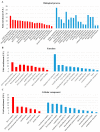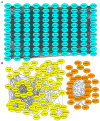Different Metabolic Pathways Are Involved in Response of Saccharomyces cerevisiae to L-A and M Viruses
- PMID: 28757599
- PMCID: PMC5577567
- DOI: 10.3390/toxins9080233
Different Metabolic Pathways Are Involved in Response of Saccharomyces cerevisiae to L-A and M Viruses
Abstract
Competitive and naturally occurring yeast killer phenotype is governed by coinfection with dsRNA viruses. Long-term relationship between the host cell and viruses appear to be beneficial and co-adaptive; however, the impact of viral dsRNA on the host gene expression has barely been investigated. Here, we determined the transcriptomic profiles of the host Saccharomyces cerevisiae upon the loss of the M-2 dsRNA alone and the M-2 along with the L-A-lus dsRNAs. We provide a comprehensive study based on the high-throughput RNA-Seq data, Gene Ontology and the analysis of the interaction networks. We identified 486 genes differentially expressed after curing yeast cells of the M-2 dsRNA and 715 genes affected by the elimination of both M-2 and L-A-lus dsRNAs. We report that most of the transcriptional responses induced by viral dsRNAs are moderate. Differently expressed genes are related to ribosome biogenesis, mitochondrial functions, stress response, biosynthesis of lipids and amino acids. Our study also provided insight into the virus-host and virus-virus interplays.
Keywords: RNA-Seq; Saccharomyces cerevisiae; dsRNA viruses; host gene expression.
Conflict of interest statement
The authors declare no conflict of interest. The founding sponsors had no role in the design of the study; in the collection, analyses, or interpretation of data; in the writing of the manuscript, and in the decision to publish the results.
Figures






Similar articles
-
Relationships and Evolution of Double-Stranded RNA Totiviruses of Yeasts Inferred from Analysis of L-A-2 and L-BC Variants in Wine Yeast Strain Populations.Appl Environ Microbiol. 2017 Feb 1;83(4):e02991-16. doi: 10.1128/AEM.02991-16. Print 2017 Feb 15. Appl Environ Microbiol. 2017. PMID: 27940540 Free PMC article.
-
Molecular characterization of a novel mycovirus in Alternaria alternata manifesting two-sided effects: Down-regulation of host growth and up-regulation of host plant pathogenicity.Virology. 2018 Jun;519:23-32. doi: 10.1016/j.virol.2018.03.027. Epub 2018 Apr 6. Virology. 2018. PMID: 29631173
-
Killer toxin-secreting double-stranded RNA mycoviruses in the yeasts Hanseniaspora uvarum and Zygosaccharomyces bailii.J Virol. 1994 Mar;68(3):1765-72. doi: 10.1128/JVI.68.3.1765-1772.1994. J Virol. 1994. PMID: 8107238 Free PMC article.
-
Prions and RNA viruses of Saccharomyces cerevisiae.Annu Rev Genet. 1996;30:109-39. doi: 10.1146/annurev.genet.30.1.109. Annu Rev Genet. 1996. PMID: 8982451 Review.
-
Double-stranded and single-stranded RNA viruses of Saccharomyces cerevisiae.Annu Rev Microbiol. 1992;46:347-75. doi: 10.1146/annurev.mi.46.100192.002023. Annu Rev Microbiol. 1992. PMID: 1444259 Review.
Cited by
-
Adaptive Response of Saccharomyces Hosts to Totiviridae L-A dsRNA Viruses Is Achieved through Intrinsically Balanced Action of Targeted Transcription Factors.J Fungi (Basel). 2022 Apr 9;8(4):381. doi: 10.3390/jof8040381. J Fungi (Basel). 2022. PMID: 35448612 Free PMC article.
-
The evolutionary ecology of fungal killer phenotypes.Proc Biol Sci. 2023 Aug 30;290(2005):20231108. doi: 10.1098/rspb.2023.1108. Epub 2023 Aug 16. Proc Biol Sci. 2023. PMID: 37583325 Free PMC article. Review.
-
Saccharomyces paradoxus Transcriptional Alterations in Cells of Distinct Phenotype and Viral dsRNA Content.Microorganisms. 2020 Nov 30;8(12):1902. doi: 10.3390/microorganisms8121902. Microorganisms. 2020. PMID: 33266158 Free PMC article.
-
Recent Advances in the Yeast Killer Systems Research.Microorganisms. 2023 May 1;11(5):1191. doi: 10.3390/microorganisms11051191. Microorganisms. 2023. PMID: 37317165 Free PMC article.
-
Variation and Distribution of L-A Helper Totiviruses in Saccharomyces sensu stricto Yeasts Producing Different Killer Toxins.Toxins (Basel). 2017 Oct 11;9(10):313. doi: 10.3390/toxins9100313. Toxins (Basel). 2017. PMID: 29019944 Free PMC article.
References
MeSH terms
Substances
LinkOut - more resources
Full Text Sources
Other Literature Sources
Molecular Biology Databases

